At One with Nature in HK
The first impression that most visitors to Hong Kong get – after they have negotiated their way from the airport to the city centre – is one of high rise buildings all crammed into a tiny area; and to talk to some people, you would think that this is all that Hong Kong has to boast about. I never fail to be surprised by some who have been to HK many times and genuinely don’t know that the territory (or SAR, if we are being strictly pedantic) is an incredibly green place, once you have escaped the urban environment.
Perhaps nowhere is this more so than in Hong Kong’s very own wetland park – a 60-hectare ecological park located at the northern part of Tin Shui Wai, in Yuen Long in the wetland ecosystems in the northwest of the New Territories. This is my first visit here. It’s a grismal cloudy day outside, and dark clouds are threatening scattered showers, but I’ve got my trusty umbrellarette with me to ward off the rain and I’m full of the joys of spring, ready to become one with nature!
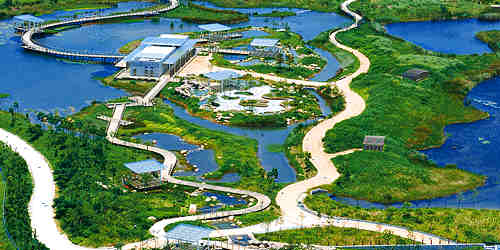
According to the official blurb, the park is home to an impressive cast of wildlife, including birds, butterflies and dragonflies, amphibians, reptiles, mammals and fish. There are also nature trails, bird hides and viewing platforms making it a handy and excellent spot for bird-watching.
Just inside the entrance is a maze made out of hedging; but as it is all below waist height, it is hardy what one might call difficult to work a route through the labyrinth. I’m assuming that in time it will grow taller and become more of a challenge. Or maybe they will leave it like it is in order to appeal to the kids. Certainly today no-one pays it the slightest bit of interest.
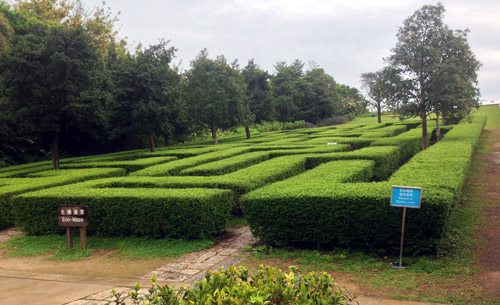
Hong Kong Wetland Park was designed to be a so-called ‘ecological mitigation area’ for the wetlands lost due to the development of Tin Shui Wai New Town.
It comprises a 10,000-square-metre visitor centre, called ‘Wetland Interactive World’, and a 60-hectare Wetland Reserve.
In 1998, a feasibility project was initiated by the Agriculture, Fisheries and Conservation Department and the Hong Kong Tourism Board with a view to expanding the ecological mitigation area to a wetland ecotourism attraction. It became one of the Millennium projects of the new SAR Administration. A decade later – in 2007 – the park was one of five winners of the 'Awards for Excellence: Asia Pacific Competition', from the Urban Land Institute.
First up, its straight into the Wetland Interactive World which has themed exhibition galleries, a theatre, a souvenir shop, an indoor play area and a resource centre. It is teeming with kids on organised school expeditions, and I wonder if it was really such a great idea coming here. But my forebodings are soon laid to rest.
A mural has me wondering if I really am going to see kingfishers scooping up fish while a croc, frogs, birds, butterflies and insects look on. Well, maybe this is what they call artistic licence, LOL!
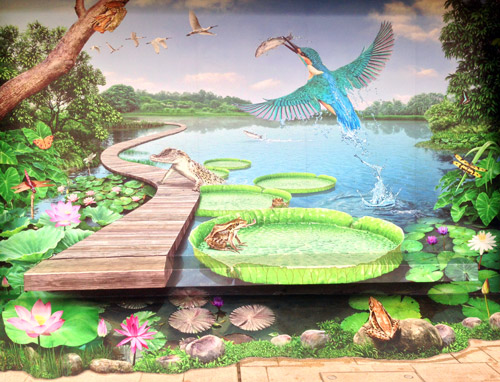
The exhibitions showcase the importance of wetlands conservation; but far from being a boring educational diatribe on saving the planet, (most of) the galleries are pretty good. There’s one especially in which you can view both above and below water level to see the diversity of pond and tropical swamp life.
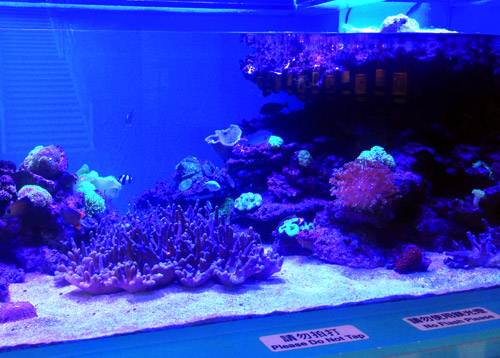
I’m not sure where in the overall ecological scheme of things a tiger fits in. Did they really have tigers running amok in Kowloon in the days of yesteryear? I queue up to have my photo taken with the handsome beast.
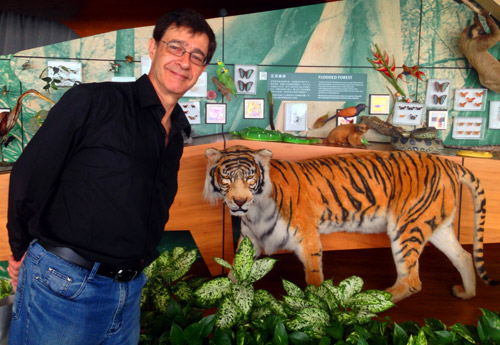
Not all the exhibits are as lucky as the tiger, however. This duck, it would appear, is under repair… But when will marketers discover that the general public really isn’t as stupid as they would have us believe? Exhibits don’t get repaired to serve us better. They get repaired when they start falling apart. It’s as basic as that. Puh! Marketing! Who needs it!

The Swamp Gallery is pretty impressive. Once again we can take a peek both above and below the waterline.
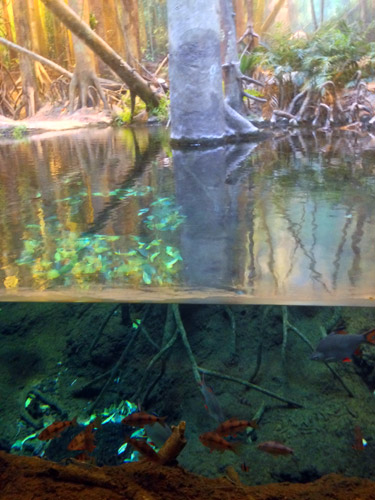
And what’s this? Is that a croc I see peering out from the water?
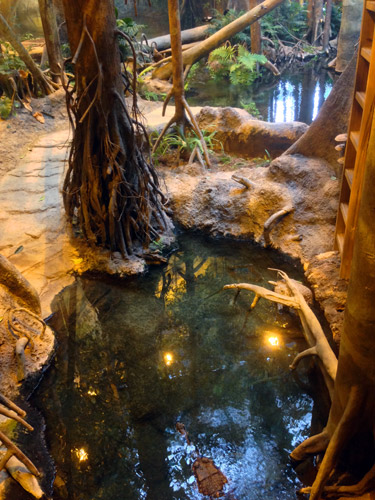
Elsewhere there are giant insects strung up around the place. Not very scary when you see the multiple lines supporting them from falling onto the visitors below…
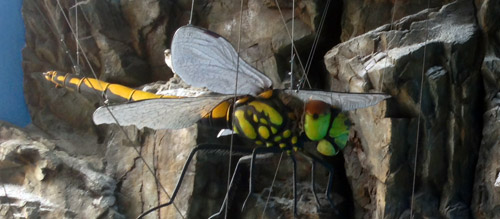
It turns out that HK Wetlands does indeed have a pet croc. Pui Pui is its name. (Apparently that’s a pun indicating that it came from Shan Pui River and is the ‘apple of the public's eye’.)
In August 2006 she was moved into her landscaped enclosure measuring 8 by 9 metres, of which 70% is pool area. With a maximum depth of 1-metre, the pool is landscaped with plants to provide sheltered areas, hiding places and basking areas for the reptile. Outdoor facilities include infra-red heaters, a heat pad and a weighing scale. Water in the pool is continuously circulated through a filtration system. Sounds idyllic. One happy crocodile!
But a croc is a croc is a croc, as far as I am concerned. I rather prefer its wooden effigy which stands proudly outside the enclosure.
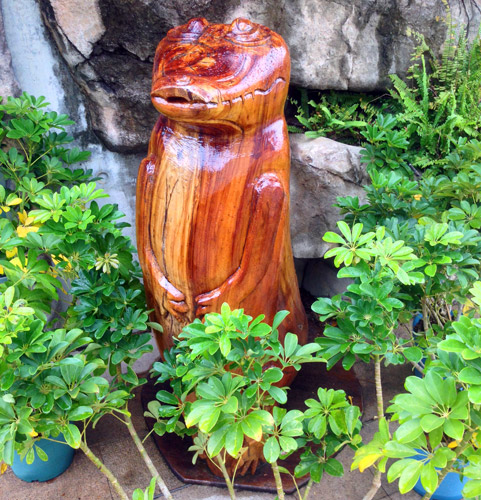
Leaving the visitor centre, a pathway meanders off into the distance. Already there are spots of rain, but it doesn’t dampen the appeal of the place.
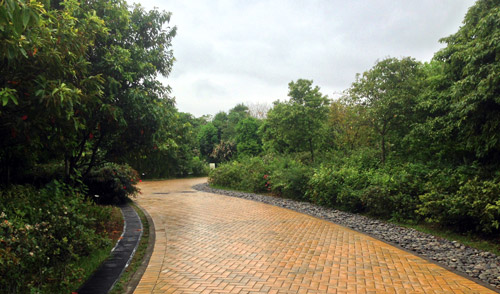
The blurb would have us believe that one of the most attractive parts of the park is the mangrove boardwalk; and websites advise it is well worth trying to visit at low tide, when the mud under the mangroves is teeming with mudskippers and fiddler crabs. I’m particularly keen to see the mangroves, having just bought some land in the Philippines which is bordered by mangroves stretching out into the sea. However, the Wetland Park is obviously trying to ‘serve us better’ since the mangrove boardwalk is closed today.
Never mind. There is plenty more to catch the eye, including some gorgeous plants bordering the walkways.
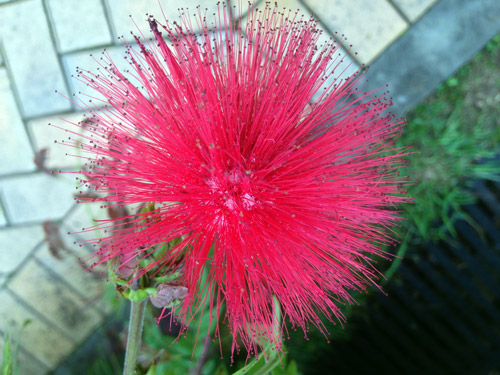
The blurb also tells us that the Wetland Reserve consists of re-created habitats designed for water fowl and other wildlife. I think if I were one I would be happy to settle here; but maybe they haven’t read the free handouts. There’s not a single animal to be seen in this area, lovely though it is …
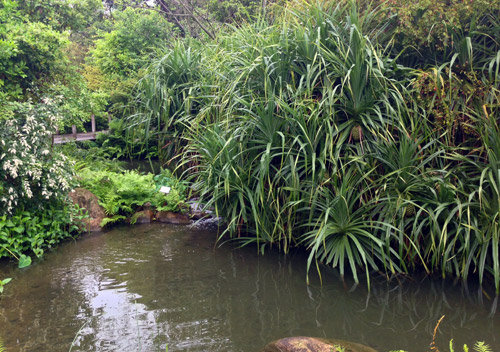
But what there are, in abundance, are signs and mocked up displays giving us an insight into what one might have seen if the animals had had the decency to read the advertising.
Here, for instance, is an explanation of how otters mark their territory…
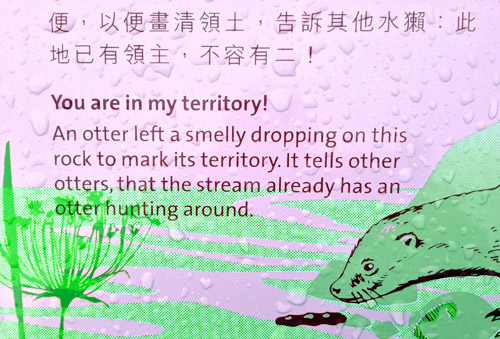
… and then it has an aluminium tube through which you look so that your eye is drawn onto what it is they are trying to describe. Simple but very effective.
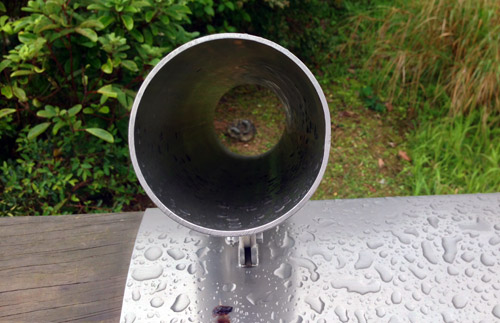
With the twists and turns, it is easy to lose your sense of direction. But everywhere there are maps pointing out what there is to see in one's particular neck of the woods.
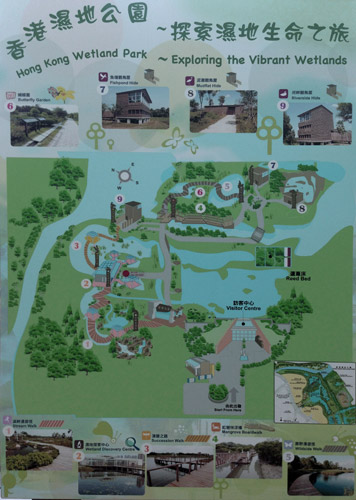
It starts to rain; but there are plenty of pavilions in which one can shelter, and take the time to enjoy the simple pleasures of nature.
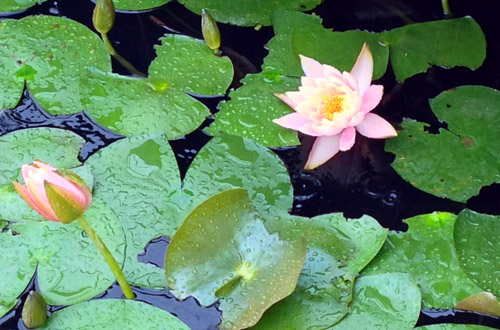
It stops raining and I cross one of the many bridges that zig-zag their way across stretches of water. We are told to mind the deep water; but I don’t mind it at all!
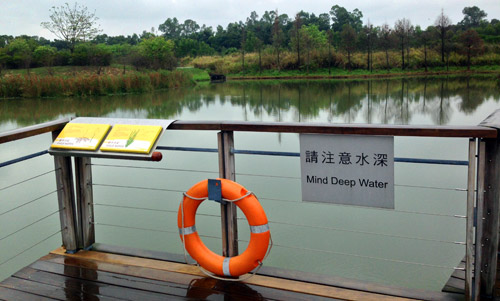
In the background is the ever-present plethora of high-rise tower blocks; but here one feels totally at peace with nature.

Throughout the park there are loads of notices telling us that birds have ears. Well, of course the signs are there to remind everyone to keep quiet so as not to scare away the wildlife. But it got me thinking. Apart from the ears you see on owls and other birds of prey, what about ordinary birds?
Well, it appears that all birds have ears – including an outer ear, a middle ear, and an inner ear, just like humans. But most birds don’t have an outside part, but instead just a hole behind and slightly below each eye. Ahh. I feel all the wiser now…
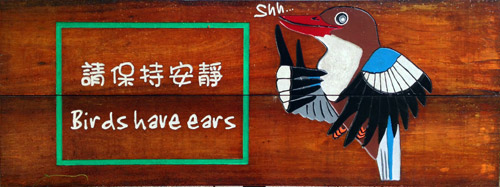
Around the park there are a number of viewing hides, and it’s from here that you start to see the abundant wildlife that obviously isn’t aware that they are being stared at from all directions. It feels a bit voyeuristic, to be honest, spying on the birds and other animals preening themselves, having sex, and getting up to all manner of things that perhaps their parents wouldn’t want to know about! (Hey son! You know what the birds and the bees do? Well, guess what – humans do it too!)
Within the hides there are quite a few binoculars and telescopes provided, though obviously on a busy day there could be quite a queue for these. Many twitchers prefer to bring their own, plus long-range camera lenses too, of course.
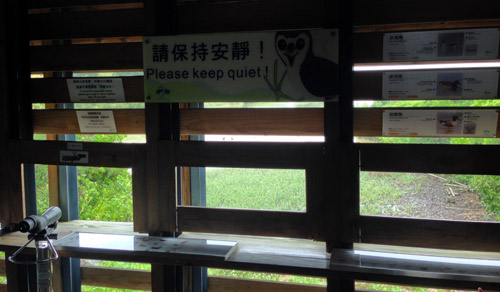
There are also ample explanatory charts so you can try to work out what on earth you are looking at and then confidently go back home and state ‘guess what… I saw a black-faced spoonbill today’ – or whatever.
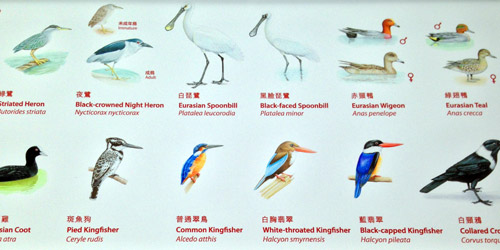
On a grey day like today, there appears little of note to see, however, except for the distant high-rises in Shenzhen, across the border in the motherland.
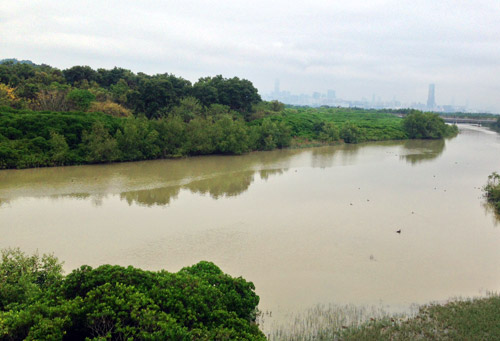
Shhhh! Oops – sorry ’bout that!
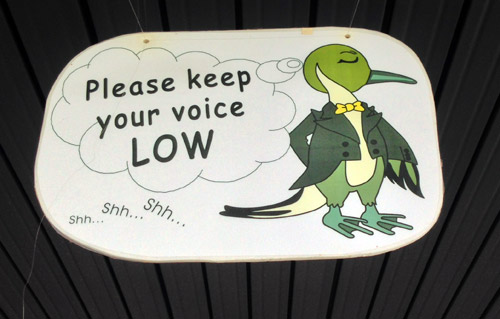
But there is still ample plant life to admire, such as this display of bougainvillea,
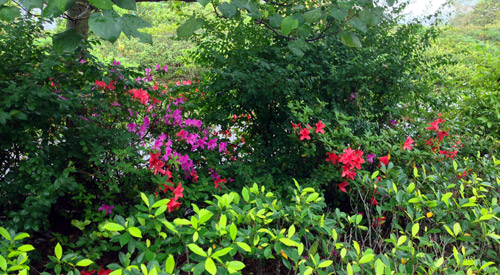
… or this plant, whose name I have no idea of …
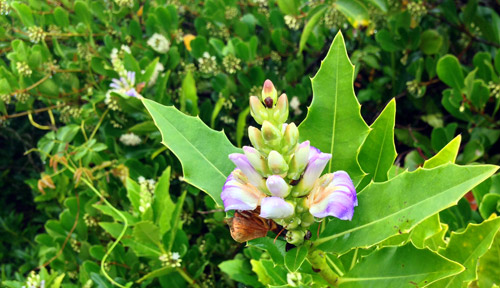
But wait a second. What’s that patch of white in the distance?
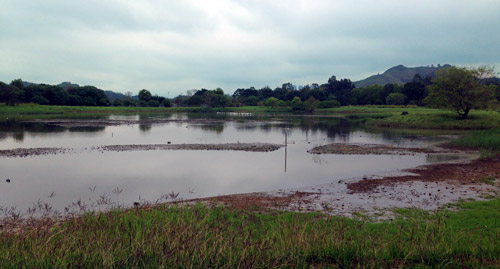
Hey – where are those binoculars? Yes – this patch of white…
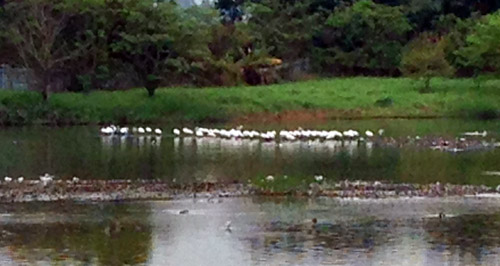
Yup. They are indeed black-faced spoonbills.
And over to the right a bit – some vultures preening themselves in the late morning mist.
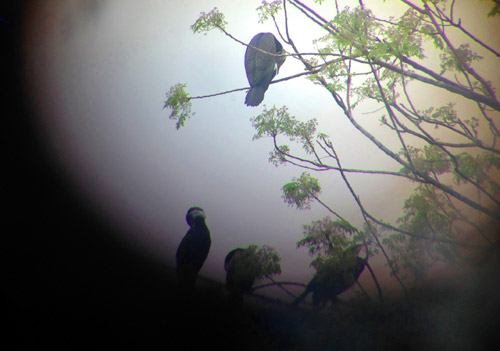
It’s time to go. At the exit, is a dancing fountain display throwing ad-hoc jets of water up in the air – the kind of display which normally gets the kids running wildly about underneath. But right now the kids are still inside the centre and it’s time to make my way back to the urban landscape.
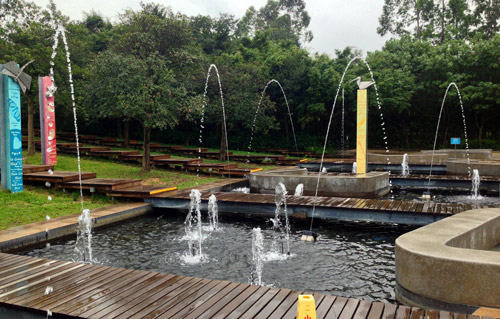
But even metropolis-land can be beautiful. It’s just a stone’s throw away to the MTR station, but here there is still plenty of bougainvillea to pose with.
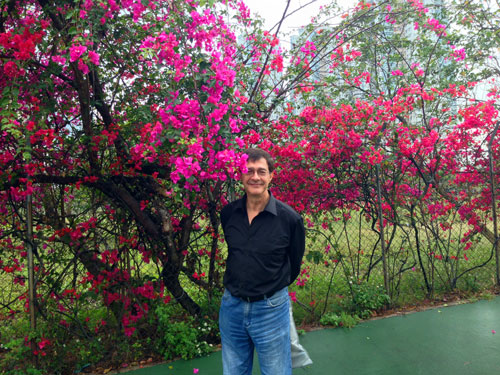
Don’t you just love Hong Kong?
